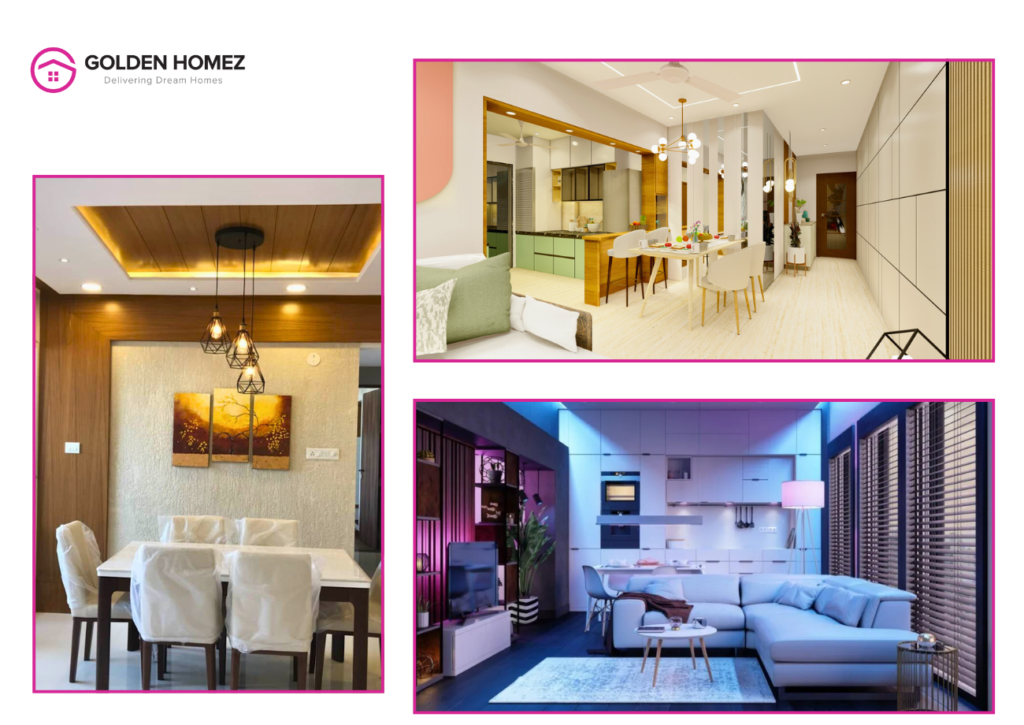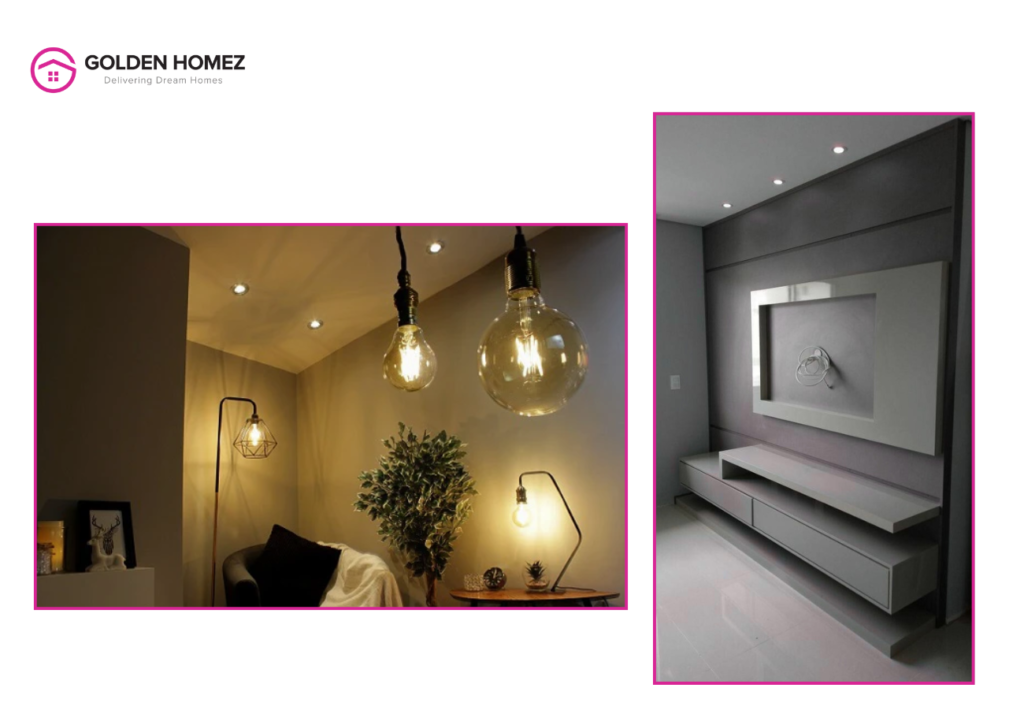Table of Contents
The center of your home is the living room. At Golden Homez, we believe this space deserves nothing but the best. We adorn it with expensive furniture, beautiful décor, the latest TV sets, plants, and more. But beyond the furniture and décor, the way you illuminate this space has a profound impact on the living room ambience and, surprisingly, your overall well-being. Understanding how lighting affects us is key—because Lighting Affects Your Living Room Ambience more than you might think. With the right lighting design, you can create a truly harmonious and mood-boosting environment.
How does lighting affects mood and health?
Bright sunny days often lift your mood and make you feel more energetic. That’s because light interacts with our bodies and brain on a deeper level.It influences how we feel and our overall health. Sunlight, especially morning light, is the main cue for your body’s internal clock. It signals the brain to promote wakefulness. As darkness falls, the brain releases sleep promoting hormone called melatonin.However, evening exposure to artificial light, especially blue light from screens interferes with this process. It suppresses melatonin and delays your sleep. Therefore, maintaining a consistent cycle of natural light during the day and minimizing artificial light at night is crucial for a healthy circadian rhythm. It influences your sleep, alertness, and overall well-being.
Effects of artificial lights :
Just like food and rest , light is a basic need. The right amount and the right kind of light at the right times helps our bodies work smoothly and keeps our sleep patterns healthy. It can even give our mood a little boost. Therefore making sure we get some natural light when possible is very important. Choosing our indoor lighting thoughtfully is a simple yet impactful way of being kind to ourselves. Because it supports our energy levels, our sleep, and our overall sense of well-being in everyday life.
The effects of artificial light vary in nature.The colour temperature and intensity of your everyday lighting significantly influence your mood and energy levels. Harsh, blue-toned led lights and their effects can be stimulating and may disrupt sleep patterns if used excessively in the evening. While beneficial for task lighting, opt for warmer, softer led lights with lower Kelvin ratings (around 2700K-3000K) to create a cozy and relaxing living room ambience, especially during the darker months.

Here’s how you can use lighting to enhance your living room ambience :
- Layer Your Light Sources: Layering is key to create depth .Combine ambient lighting (soft overhead or floor lamps), task lighting (reading lamps with warmer bulbs), and accent lighting (highlighting cozy corners or artwork with gentle washes of light). Avoid harsh, singular light sources.
- Embrace Warm Tones: Opt for light bulbs with warmer colour temperatures (yellowish hues) in your main living area, particularly in the evenings. This promotes relaxation and a sense of comfort.
- Consider Full-Spectrum Bulbs: Full-spectrum LED bulbs aim to mimic natural daylight more closely than traditional bulbs. Incorporating these into your general lighting can give a nice subtle mood boost.
- Dimmers to rescue : Use dimmers for best possible control over the intensity of lights. You can brighten the room on gloomy days and soften the glow in the evenings to create a more soothing living room ambience.
- Strategic Placement: Position lamps to avoid glare and harsh shadows. Bouncing light off walls and ceilings can create a softer, more diffused illumination.
- Integrate Smart Lighting: Smart bulbs often allow you to adjust both the brightness and colour temperature, giving you dynamic control over your lighting effects and enabling you to create different moods with ease.
LED lights and their effects :
LED lights have become favourite due to their semiconductor nature supported energy efficiency and long lifespan. Let’s take a look at their effect :
Effects of LED Lights:
- Blue Light Emission: Many white LED lights emit a significant amount of blue light, which can suppress the production of melatonin.This can disrupt the circadian rhythm, making it harder to fall asleep. It can potentially lead to long-term health issues.
- Eye Strain and Vision Problems: The high intensity and potential flicker of some LED lights can cause more eye strain, headaches, blurred vision, and fatigue. Prolonged exposure to blue light can also increase the risk of age-related blurred central vision. Children are particularly vulnerable as their eyes are still developing and absorb more blue light.

- Disturbed Circadian Rhythm : Exposure to blue-rich LED light in the evening can delay the natural onset of sleep. This can negatively impact mood, productivity, and overall health.
- Potential Benefits: During the day, blue light from LEDs can help boost alertness, just like natural sunlight. Some studies also suggest that certain types of LED lighting can improve productivity and reduce eye strain when designed correctly (e.g., flicker-free with appropriate color temperature).
- Safety: LEDs operate at lower temperatures and don’t contain hazardous substances like mercury, making them safer than some traditional lighting options.
Winter depression and top rated SAD lights:
Sunlight helps your body to release serotonin – the mood regulating hormone. During winters, lack of longer sun exposure causes decrease in serotonin levels. Additionally, increased secretion of melatonin due to darker and longer nights in winter contributes to something known as Winter depression. It is also known as Seasonal Affective Disorder- a type of depression that follows a seasonal pattern.

Treatment for winter depression often involves light therapy (using a special bright light box), psychotherapy,etc..So, what are the best lights for winter depression? While not a replacement for professional medical advice, strategically incorporating specific types of artificial light can help to replicate the beneficial effects of sunlight. This is where top rated SAD lights, also known as light therapy lamps, come into play. These devices emit a bright, full-spectrum light that can help regulate your body’s natural sleep-wake cycle and improve mood. While typically used for targeted light therapy sessions, understanding their principles can inform your general living room lighting choices. You can transform your living room into a comforting and mood-enhancing haven, no matter the season.
The primary tool used in light therapy for Seasonal Affective Disorder (SAD) is a light box or SAD lamp.
Key Features to Consider When Choosing a SAD Light:
- Lux (Light Intensity): The standard recommendation is 10,000 lux. Some lights offer adjustable intensity.
- UV Filtration: Ensure the lamp filters out most or all UV light to protect your eyes.
- Size and Design: Consider where you will use the lamp and choose a size and style that fits your needs. Desk lamps, floor lamps, and portable options are available.
- Color Temperature: Some lamps offer different color temperature settings, allowing you to adjust the light from cooler (more energizing) to warmer tones.
- Timer: Some lamps have built-in timers to help you track your light therapy sessions.
- Ease of Use: Look for lamps with simple controls and clear instructions.
- Certifications/Reviews: Check for any medical certifications or look for reviews from other users to gauge effectiveness and quality.
(It’s important to use devices specifically designed for SAD treatment and to follow the manufacturer’s instructions regarding distance, duration, and timing of use. Consulting a healthcare professional is recommended to determine the best light therapy approach for individual needs).
Conclusion:
In essence the lights are the secret ingredient to how your living room feels. It’s not just about seeing things; it’s about creating a mood. By using different kinds of lights – some for general brightness, some for specific tasks, and some to show off your cool stuff – you can make your living room comfortable, unique and functional too! Choosing the right lights and how bright or dim they are can totally change the feeling of the room, making it perfect for any time of day. Don’t underestimate your lights – they’re what really make your living room feel like home.
FAQ
What are the main types of lighting I should consider for my living room?
The three key types are ambient (general, overall light), task (focused light for activities like reading), and accent (highlighting specific features or décor).
How to create depth in a living room?
Layering is the solution. It creates depth, eliminates harsh shadows, and allows you to adjust the mood and functionality of the room for different times and activities.
What kind of light color is generally recommended for a living room?
Warmer light temperatures are often suggested for living rooms because they create a cozy and inviting atmosphere.
Is smart lighting a good idea for a living room?
Yes. In today’s age smart bulbs and systems let you easily control lights with voice or apps. This offers convenience, personalized settings, and potential energy savings too.

